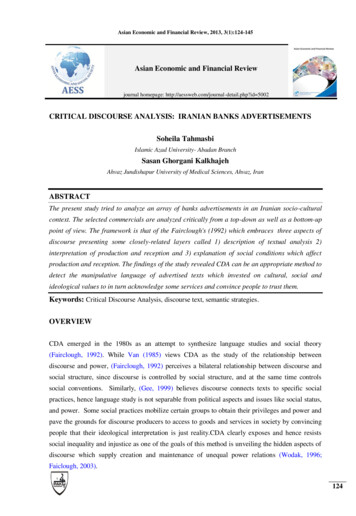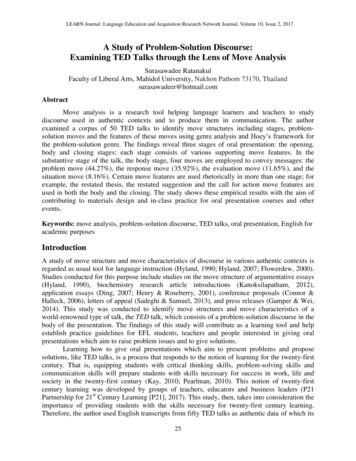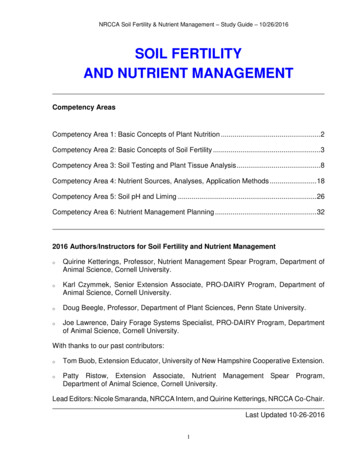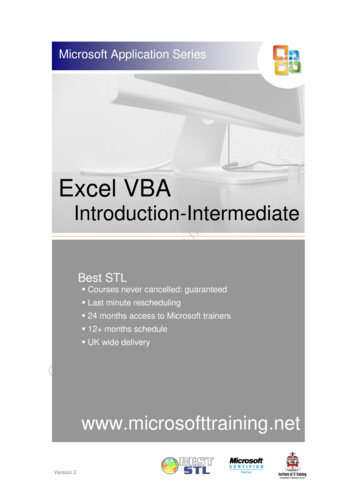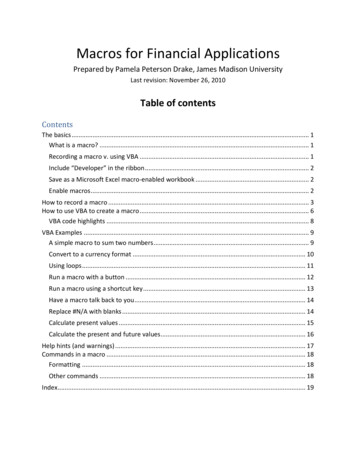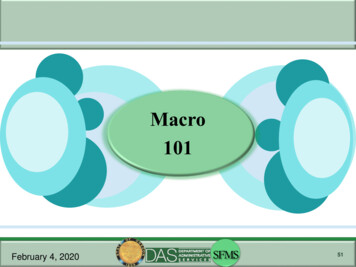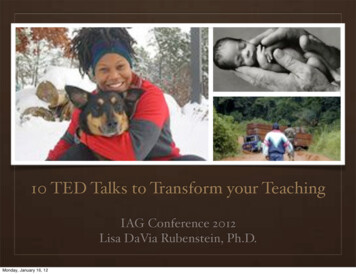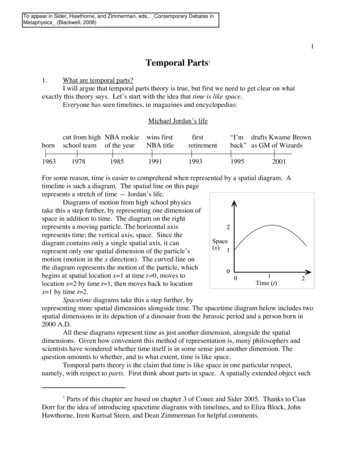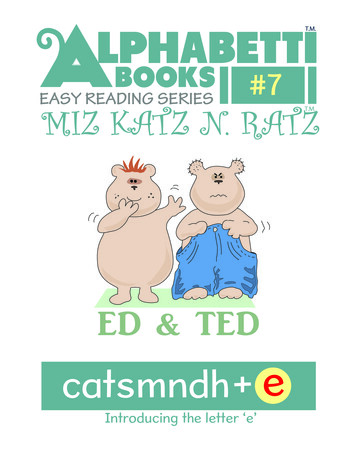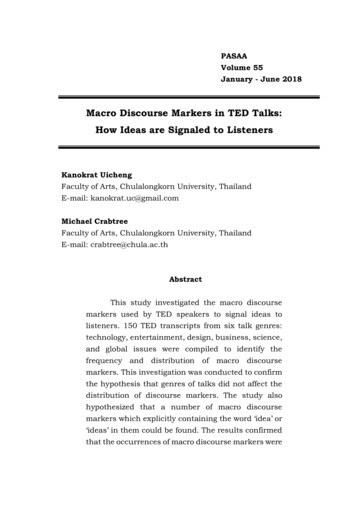
Transcription
PASAAVolume 55January - June 2018Macro Discourse Markers in TED Talks:How Ideas are Signaled to ListenersKanokrat UichengFaculty of Arts, Chulalongkorn University, ThailandE-mail: kanokrat.uc@gmail.comMichael CrabtreeFaculty of Arts, Chulalongkorn University, ThailandE-mail: crabtree@chula.ac.thAbstractThis study investigated the macro discoursemarkers used by TED speakers to signal ideas tolisteners. 150 TED transcripts from six talk genres:technology, entertainment, design, business, science,and global issues were compiled to identify thefrequencyand distributionof macrodiscoursemarkers. This investigation was conducted to confirmthe hypothesis that genres of talks did not affect thedistribution of discourse markers. The study alsohypothesized that a number of macro discoursemarkers which explicitly containing the word ‘idea’ or‘ideas’ in them could be found. The results confirmedthat the occurrences of macro discourse markers were
2 PASAA Vol. 55 January - June 2018not subject to talk genres and that 51 markerscontaining the word ‘idea’ and ‘ideas’ were found.Keywords: discourse marker, macro discourse marker,idea signalers corpus-based study, public talk, talkgenresIntroductionWhen listening to a public speech, one may notice that munderstanding the message that the speaker is trying to deliver.Sometimes it is the speed or pace of speaking which might be toofast to follow. Sometimes it is the complexity of concept which is notclearly explained by the speaker. As a result, most listeners need tocount on linguistic devices like discourse markers to help themcomprehend the speech better. While some discourse markers workas pause fillers, others work as sequence, fact, or idea signalers.Several studies agree that discourse markers help listenersto understand academic spoken discourse like lectures, more easily(Chaudron & Richard, 1986; Flowerdew & Tauroza, 1995; Rido,2015). However, only a small number of studies have investigatedspecifically how speakers use discourse markers to aid a successfultalk. This is possibly because most researchers have not identifieda group of speakers who represent a successful model that they canstudy for the way discourse markers are used. This study, however,argues that TED Talk speakers represent such a model and thatone can learn from them the role that discourse markers play intheir proficiency as public speakers.TED is a non-profit organization which offers short powerfultalks on various topics to audiences around the world. People caneither attend their live conferences or watch TED talk videos online.The topics of TED talks vary, although most can be grouped underone or more of the following: technology, entertainment, design,business, science, and global issues. There are approximately 2,700talks available on the internet and their popularity has beenincreasing. One talk by Sir Ken Robinson about education and
PASAA Vol. 55 January - June 2018 3creativity, for example, has been viewed more than 50 million timesand has been translated into more than 60 languages. TEDspeakers have also been recognized in a number of studies, whichhave attempted to identify features of TED talks which distinguishthem from other types of spoken discourse.For instance, Caliendo and Compagnone (2014), who definedTED Talks as speech events where speakers from different fieldsshare their knowledge with a large audience, compared TED Talkspeakers to university lecturers in their use of ELVs, or epistemiclexical verbs. The four most recurrent ELVs: see, show, know, think,were investigated using two corpora of spoken discourse: TED acand MICASE. The results showed that unlike in lectures, thepronoun ‘we’ as used in TED talks, typically included the speakersand their team but excluded the audience. Their use of ‘we’, as inwe see, we know, and we think, helped TED speakers build animage of themselves as experts who delivered their stories ordiscoveries confidently. This particular use of epistemic lexicalverbs with the pronoun ‘we’ was identified as one element thatdistinguishes TED Talk speakers from university lecturers.Tsai (2015) also compared TED speakers with universityprofessors, but in terms of prosodic voice characteristics. His mainaim was to identify the characteristics that distinguished TEDspeakers from other public speakers. He collected 5-minute audiosamplesfromTEDtalksand lectures,thendevelopedadiscriminative classifier to predict whether the samples were fromTED talks or from lectures. Predictions were based on a set offeatures derived from pitch and energy. It was found that TED talkstended to be more ‘dense’ in that there was less time in silence andmore time in high-energy speech. TED speakers were alsoconsistent in delivering lengthy messages while lecturers werefound to have more varied chunks of silence and speech. The studyalso suggested that TED speakers had deeper voices than universityprofessors. Tsai pointed out that these results were possibly due tothe fact that TED talks were shorter than the lectures. Furthermore,he suggested that one element that made TED Talk speakerssuccessful public speakers is their ability to deliver a consistently
4 PASAA Vol. 55 January - June 2018high-energy talk. In Tsai’s opinion, TED talk speakers ‘havesomething to say and know how to say it’ (p.4).Chris Anderson, the Head of TED Talk, however, views TEDspeakers from another perspective. He believes that all TEDspeakers have one element in common. That element is their ‘idea’which they see as worth sharing with the audience. Despite the factthat TED speakers talk on different topics, they have the same goal,which is to successfully deliver their ideas to the listeners. This,Anderson suggests, is the key common feature shared by TEDspeakers.Given the time limitation of approximately 20 minutes andthe large audience from different backgrounds, TED speakers needto be clear when they deliver their ‘ideas’. They must ensure thatall listeners are with them and do not miss any important conceptsduring the talk. This is where discourse markers are believed to playa role. A discourse marker is a linguistic feature that helps indicaterelations between utterances in the discourse. With ideas aselements to deliver, it is assumed that TED speakers use discoursemarkers to signal their thoughts. This study aims to identify suchdiscourse markers used by TED speakers, especially whatChaudron and Richards (1986) term the macro version, such as ‘Ibelieve’ and ‘the point is’.Review of the LiteratureDiscourse Markers: Terminology and DefinitionsThe markers which are the focus of this study are macrodiscourse markers. However, when researchers use the term‘discourse marker’ in general and more specifically, the term ‘macrodiscourse marker’, they do not always use them to refer to exactlythe same elements.For example, Chaudron and Richards (1986) proposed thatthere are four versions of lecture discourse where the use ofdiscourse markers could be found: 1) baseline version, 2) microversion, 3) macro version, and 4) micro-macro version. The term‘version’ here, as the researcher understands it, refers to the type oflecture, considering this explanation by Chaudron and Richards:
PASAA Vol. 55 January - June 2018 5A second version of the lecture, the ‘Micro’ version, was thenconstructed, in which various markers of 1ntersentential relations,framing of segments, and pause fillers, were inserted.Chaudron and Richards (1986:71)From this excerpt, it is clear that the term ‘version’ refers toa type of lecture. The term ‘markers’ being used here also refers to‘discourse marker’, as the title of the paper, The Effect of DiscourseMarkers on the Comprehension of Lecture, suggests. Chaudron andRichards divided lectures into four types and identified discoursemarkers found in each type of lecture. Below are examples of thediscourse markers found in four different lecture versions.The first version of lecture is called the baseline version.Chaudron and Richards claim that there are no markers needed forthe baseline version of lecture. All of what appears in the discourseis necessary to convey the meaning. For example, every word in thissentence, By 1803, the original 13 colonies had doubled in size asexemplified by Chaudron and Richard, is semantically required.The second type of lecture discourse is called the microversion. Markers in this version signal intersentential relations,frame segments, and fill pauses. They can be divided into 5 subcategories: which are temporal link, causal link, contrastiverelationship, relative emphasis, and framing or segmentation.Following are examples of markers in each type as suggested byChaudron and Richards.Temporal link: then, and, now, after this, at that timeCausal link: because, soContrastive relationship: but, actuallyRelative emphasis: you see, unbelievably, of courseFraming / segmentation: well, ok, alright?The third type is called the macro version. Markers in thislecture type can be signalers or metastatements that indicate majorpropositions or important transition points in the lecture. Examplesof these markers are:
6 PASAA Vol. 55 January - June s go back to the beginning, What I’m going to talk about todayThat/this is why As you may have heardThe last type is called the micro-macro version. The namesuggests that this is a combination between the micro versionlecture and macro version lecture. The markers from both types areused together as in these examples provided by Chaudron andRichards.Well, to begin with,And so, what we’ve come to by now was that,However, similar to other researchers (Morell 2000, Bellés2004, Rido 2010) who called the discourse markers in Chaudronand Richards’ study ‘Micro markers’ and ‘Macro markers’ after thenames of the lecture types, this present study calls the markers inmicro version and macro version lectures ‘micro discourse markers’and ‘macro discourse markers’, respectively.Unlike Chaudron and Richards who examined markers inthe discourse of lectures, Schiffrin (1987) studied the use anddistribution of markers in everyday discourse. She defineddiscourse markers as ‘sequentially dependent elements that bracketunits of talk’ (p.57). Markers as defined by Schiffrin are nonobligatory and syntactically detachable. They usually occur asutterance initials that correlate with ongoing talk and text. Thesediscourse markers appear in several word classes, such as,conjunctions, interjections, adverbs, and lexicalized phrases.Following are Schiffrin’s examples of discourse markers from eachclass.Conjunctions: and, but, orInterjections: OhAdverbs: now, thenLexicalized phrases: y’know, I meanWithout looking at any particular types of discourse, Fraser(1996), classified ‘discourse markers’ as a type of pragmatic marker.
PASAA Vol. 55 January - June 2018 7In his definition, a discourse marker refers to an expression thatsignals the relationship between a basic message and the foregoingdiscourse. This marker does not influence the representativesentence meaning, but only helps to mark the procedural meaning,as in this example: Mary went home. After all, she was sick. Thismarker ‘After all’ does not change the representative meanings ofthe two sentences. It only signals to the readers that there is arelationship between these two incidents: Mary went home and Shewas sick. This marker ‘after all’, as well as items such as thus,moreover, however, and in other words are Fraser’s examples ofdiscourse markers.Another researcher who studied discourse markers in lecturediscourse is Morell (2000). She investigated the role of discoursemarkers in two types of lectures: interactive and non-interactive.Morell adopted Chaudron and Richards (1986)’s classification ofmicro and macro markers but made some addition to the subcategory of micro markers. Following are examples of discoursemarkers from her classification.Non-interactive Micro-markersSegmentationOk, and, or,now, wellTemporalAnd then,after thatCausalSo, thatmeans,whichmeans,because,so (that),thereforeContrastBut,althoughEmphasisIn fact, ofcourse,such as,noteElicitationReady?ContrastBut, unlessEmphasisOf course,as youknowElicitationAnythingelse?What?Why not?LouderpleaseInteractive Micro-markersSegmentationOk, and, or,now, anywayTemporalThenCausalSo
8 PASAA Vol. 55 January - June 2018Non-interactive Macro-markersStarterToday I’mgoing totalkabout Tobegin Thereasons ElicitationWhat do wemean by Remember Anyquestions.Accept-AttitudinalI woulddare tosay.I believethat I wouldn’tdoubt it.MetastatementI have a quotefor you I’d like to readthis to you ConclusionWhat youhave seenin thislecturefirst was AttitudinalI think It’s adifficultquestion toanswer.MetastatementTo back upthat statementConclusionTo finishtoday’slecture,We’llcontinuewith thistomorrowInteractive Macro-markersStarterWe aregoing togetstartedCan Ihave yourattention?We willbegin nowElicitationI have aquestionfor you.Do youthink ?Do youagree ?AcceptThat’sright.That’A more recent definition of discourse marker is that proposedby Carter and McCarthy (2006). Similar to Fraser (1996), Carter andMcCarthy defined ‘discourse marker’ as a sub-type of pragmaticmarker. The two researchers divided pragmatic markers into 1)discourse markers, 2) stance markers, 3) hedges, and 4)interjections. The discourse markers in Carter and McCarthy’sschema include expressions like so, well, and anyway.It can be seen from all the definitions above that researchershave approached discourse markers differently. Some specifieddiscourse markers in particular types of discourse such as lectures,while others defined ‘discourse marker’ in more general term.Moreover, since their definitions of discourse markers differ, thefunctions of markers are not the same. Discourse markers asdefined by Chaudron and Richards, for example, can performvarious functions from linking, signaling relationships, signalingtransition points, or filling pauses, while in Fraser, the function ofmost discourse markers is to mark the procedural meaning. It isnecessary to consider both discourse types and functions when onewould like to adopt a particular definition of discourse markers intheir study.
PASAA Vol. 55 January - June 2018 9Discourse Markers in this StudyThis study finds the classification of discourse markersproposed by Chaudron and Richards best fits its purposes. WhileSchiffrin focuses on discourse markers in everyday discourse,which may include conversations and written texts, Chaudron andRichard focus only on lectures. TED talks may be considered assimilar to lectures in that both are delivered by a speaker who talksin a highly monologic manner, in academic spoken discourse, andin front of a large audience. It is assumed, therefore, that theclassification of discourse markers in lectures is applicable to theclassification of discourse markers occurring in TED presentations,although the distinction between markers found in the twodiscourses might be a topic for later investigation.While the present study adopts the taxonomy of discoursemarkers posited by Chaudron and Richard, it also uses the list ofmarkers in Morell as a guideline for the manual investigation ofdiscourse markers in the first part of the data collection. However,this study does not intend to explore discourse markers of anyfunctions. Rather, it aims to look particularly for markers that TEDspeakers use to signal ideas, and therefore macro discoursemarkers seem most relevant. Another reason for choosing macrodiscourse markers is that a large number of previous studiesinvestigated the use of micro discourse markers (e.g. well, really,you know?) while relatively few have investigated macro discoursemarkers. Most macro DMs are, therefore, still unexplored. Thisstudy aims to fill this gap by studying the use of macro discoursemarkers in the spoken discourse of TED talks, especially whenthose markers signal ideas to the listeners.Previous StudiesDiscourse markers have been the subject of investigation innumerous studies and in a variety of languages (Roggia nvestigated the use of markers in written discourse (Zhang 2000,DÜlger 2007, Jalilifa 2008, Rezanova & Kogut 2015,) but in others,
10 PASAA Vol. 55 January - June 2018including the present study, the focus has been on discoursemarkers used in spoken discourse.Studies that Investigated Discourse Markers in SpokenDiscourseLee-Goldman (2010) studied different senses of ‘no’ via twospeech corpora: the ICSI Meeting corpus and the Fisher EnglishTraining Corpus. He found that, in addition to the normal sense of‘no’ as negation or rejection, there are three more senses of ‘no’ asdiscourse markers. ‘No’ as a discourse marker involves: 1) topicshifting, 2) misunderstanding mitigation, and 3) turn-takingmanagement. Following is an example of ‘no’ used as a discoursemarker to shift from a joke and then return to the conversation.1 B: i did and i started thinking about it and i contributed2 it all to my mother3 [ha ha it’s all on her side of the family] ha ha ha ha4 A: [ha ha ha ha ha ]5 A: maternal heart attack6 B: yes7 A: ((laugh))8 B: yes9 B: i blame her10 B: - but no um11 B: -- so that’s how i kind of got involved cause i like doing this12 B: stuff you know and uh13 B: it’s interesting and you know and i enjoy talking to other 14 peopleand Lee-Goldman (2010: 9)By providing evidence of ‘no’ functioning as a discoursemarker, Lee-Goldman also pointed out that ‘no’ does not alwaysoccur alone but can be accompanied by another discourse marker,such as ‘but’ as in the excerpt above.In a later study, Tay (2011) examined the co-occurrences psychotherapeutic talks. He analyzed two extracts obtained fromthe Counselling and Psychotherapy Transcripts published online byAlexander Street Press. In the first extract, Tay investigated thepatient’s use of discourse markers which were followed bymetaphoric utterances. He discovered that the patient repeatedly
PASAA Vol. 55 January - June 2018 11used the discourse markers, ‘I mean’ and ‘you know’ (or you knowwhat) to discuss a situation to which the therapist could relate. Inthe second extract, Tay investigated the discourse markers used bythe therapist to explain an abstract concept to the patient. He foundthat the therapist also used the discourse markers ‘you know’,‘and’, and ‘right?’ frequently with the patient. These three markerspreceded metaphoric utterances as can be noticed below in this partof the excerpt.“If you have this huge – you know, it’s kind of like even anexample – and we have to begin wrapping up. But like -you know,like a person – the people who have to disbomb bombs? You know– I forget what they call them, but if a building even called, thebomb squad comes in, right?”Tay then concluded that metaphors and discourse markersare co-occurring features found in psychotherapeutic talks. The useof discourse markers, both by patient and the therapist, wasmotivated by the metaphoric expressions that followed.In response to a perceived lack of research into discoursemarkers in languages other than English, Lai and Lin (2012)designed a study that looked specifically into the use of Chinesediscourse markers by Chinese-speaking seniors in descriptive rswithAlzheimer’s disease (AD) and another thirty seniors without ADparticipated in this study. The findings revealed that both groups ofparticipants used more discourse markers in the narrative taskthan in the descriptive task. However, the group with AD used thediscourse markers with less frequency and variation. The discoursemarkers frequently used by the participants with AD were, forexample, 应该 (should), 好像 (seem), and 大概 (probably).Studies that Specifically Investigated Macro DiscourseMarkersBellés (2004) investigated the similarities and differences ofdiscourse markers used in American and British lectures in theSocial Sciences. She compiled a corpus which comprised twenty
12 PASAA Vol. 55 January - June 2018transcripts, ten American English lecture transcripts from theUniversity of Michigan and ten British English lecture transcriptsfrom the University of Birmingham.The result of her corpusinvestigation showed that there were similarities in the use ofmacro-markers between American and British English lectures.Both tended to use the same macro-markers, especially in thesefollowing types: metastatements, attitudinal, and starter. However,Bellés found a distinction between the use of two metastatementmacro-markers: Let me (lemme) and let’s. American lecturers usedthese two markers more frequently, especially Let me or lemme,which did not occur in the British lectures at all. This findingimplied, as suggested by Bellés, that American lecture discourseuses less formal speech features than British lecture discourse.Rido (2015) investigated the use of discourse markers inscience lectures by a professor of physics in a university inMalaysia. The investigation was done by observing and recordingtwo of her lecture sections to identify discourse markers usedduring the lessons. Two types of discourse markers were found. Thefirst type was macro markers which functioned as rephrasers andtopic shifters. To rephrase what had been said, the lecturer in thisstudy used that mean, I mean, and which means to say that. Shewas also found using ‘so’, ‘now’, and ‘so anyway’ as topic shifters.The second type of marker was the micro marker. Rido identifiedtwo sub-types of markers in this group: additional makers andcausal markers. Both were used to signal internal or ideationalrelations within the sentences. The additional markers found were‘and’ and ‘or’ while the causal marker found was ‘because’. Ridobelieves that the use of these discourse markers can help thestudents to comprehend the ofdiscourse markers which have been investigated in differentcontexts and different types of discourse. One of the most frequentlyexamined types of discourse among researchers is the lecture.However, the discourse markers examined in most studies onlectures were often one of these: so, well, right, now, really, I mean,and you know. This present study seeks to identify a wider range of
PASAA Vol. 55 January - June 2018 13discourse markers, especially the macro version, which TEDspeakers use to efficiently deliver ideas. Specifically, the studyattempts to answer the following research questions:Research Questions1. What are the macro-discourse markers used to signal ideasin TED Talk presentations?2. Are the macro discourse markers found in TED talks specificto the topics of the talks, or are they equally distributedacross different genres?The hypotheses which the study sets out to test are:Hypotheses1. There will be a wide range of macro discourse markers usedto signal ideas in TED Talk presentations.2. Many macro-discourse markers contain the word ‘idea’ or‘ideas’.3. There are no significant differences between the distributionsof macro-discourse markers across TED Talk genres.Research MethodologyCorpora and Data CollectionThe data in this study came from two corpora. One corpus(hereinafter TED-dm) is a compilation of 150 TED talk transcripts,25 each from six popular topics: technology, entertainment, design,business, science, and global issues. This corpus is used to confirmthe occurrences and frequency of macro discourse markers foundin each type of talk. Another corpus is called TCSE, or the TEDCorpus Search Engine, developed by Yoichiro Hasebe from Japan.This corpus has a large database of 2,589 TED talk transcripts withover 6,245,134 elements. The number of transcripts in this corpusis close to the number of talks available on the official TED site(around 2,700 videos). For this reason, the corpus is consideredas having data representative of TED talks generally and thereforeis used in this study as a reference corpus.
14 PASAA Vol. 55 January - June 2018Data PreparationIn order to compile the TED-dm, 25 transcripts from each ofsix talk genres were specified. This was done by using the browsingtools of the official TED site. The duration of talks was set for 12 to18 minutes and the topics selected were from the six most populargenres. Once the duration and topics were set (Ex. Technology, 1218 minutes), TED displayed a long list of videos starting from thepresent year (2018) to the first year in which TED talks were given(2006). Initially, the researcher intended to select the 25 mostcurrent videos from each genre list. However, this provedproblematic as some videos appeared under more than one topicand therefore, it was not clear to which topic such videos should beassigned. For example, the talk ‘What is it like to be a robot’ givenby Leila Takayama, appeared under both technology and design. Ifthis talk were assigned to either genre, we would not be able togeneralize the distribution of macro discourse markers in these twodifferent genres. Hence, any videos appearing with more than oneof these six topics tags: technology, entertainment, design,business, science, and global issues, were not included in thestudy. Only the videos with a single tag from these categories wereselected, despite the different year in which they were given.Data AnalysisAfter all 25 transcripts from talks on the six topics werespecified and collected, the two most recent transcripts from eachtopic were manually analyzed to identify the macro-discoursemarkers. Within one transcript, a speaker can use several macrodiscourse makers, but this study only looked for markers thatintroduced, expressed, or signaled ideas. For example, in the twoexcerpts below, the marker ‘But I want to be clear’ was chosen forthe study while the marker ‘let me give you an example’ was not,because the latter told ‘information’ rather than signaled an ‘idea’.“But I want to be clear: postpartum hemorrhaging – it’s not aRwanda problem, it’s not a developing-world problem – this is a globalproblem.”Keller Rinaudo, 2017
PASAA Vol. 55 January - June 2018 15“Let me give you an example. A couple months ago, a 24year-old mother came into one of the hospitals that we serve, andshe gave birth via C-section. But that led to complications, and shestarted to bleed.”Keller Rinaudo, 2017Following are the macro-discourse markers found in the twotranscripts taken from each talk genre by manual investigation.TechnologyI think / if you want to / one thing that / the reason is / ButI want to be clear / So picture that for a momentEntertainmentI want you to picture this / I start to wonder / it turns out /I learned that / what if / I mean / And remember this.DesignI believe / I’d like for you to just think about / Here’s the thingBusinessSo, three things that I have learned / I learned that / So Irealized that / I’ve also discovered that / This is because /That’s because / But my point is thatScienceThe reason that is / So the first thing that we discovered /you’ll notice / that’s why / Imagine if / what if / So in thiscase / Try to think about / So now we know that / So supposenow / But the question is / But the reason why is / wediscovered that / so as you can imagine / If you think aboutGlobal IssuesI’m going to focus on / We realized / Here’s what I’ve learnedTo ensure that these markers are in fact signaling ideas, onenative speaker of English was asked to read the concordance linesin which these markers occurred and see whether he agreed withthe list. Once the list was confirmed, the corpus TED-dm was usedto identify the occurrences and frequency of these discoursemarkers, genre by genre.One can notice, however, that some of the macro-discoursemarkers in the list above co-occurred with micro markers in frontof them, such as, and remember this, but my point is that, and so Irealized that. These micro markers are considered part of the macro
16 PASAA Vol. 55 January - June 2018markers’ variations and therefore were not included when searchingthe corpus. The complimentizer ‘that’ and possessive pronouns like‘my’ were likewise excluded due to the fact that they too, wereoptional and subjective to the speakers. The example belowillustrates when the marker ‘but my point is’ was investigated in theTED-dm topic-specific sub-corpora.Figure 1: The result when searching ‘point is’ from the Technology subcorpus of TED-dm using Antconc programThe result shows that from the 25 TED transcripts under thetopic ‘technology’, there were three occurrences of the marker ‘Thepoint is’, one with the micro marker ‘so’ and two without it. The nextstep in the analysis was then to read each concordance line and seeif the marker really introduced or signaled an idea. The frequencyof instances where the markers introduced ideas was counted. Thisprocess was applied to every marker in the list and with every TEDdm sub-corpus ranging from technology to entertainment, design,business, science, and global issues. The TCSE corpus was alsoused to confirm the frequency of each marker in TED talks ingeneral. This step marked the end of the first part of data collection.
PASAA Vol. 55 January - June 2018 17In the second part, data collection no longer investigated thediscourse markers mentioned above. As the study hypothesizedthat macro-discourse markers specifically containing the word‘idea’ or ‘ideas’ must also occur, each TED-dm sub-corpus wassearched using these two keywords. Once again, there wereconcordance lines to analyze and those with macro discoursemarkers signaling ideas were counted. For example, the data belowshows instances with the word ‘idea’ in them but only numbers 12,22, 26, and 29 were counted. This step in the investigation markedthe end of all data collection.Figure 2: The result when searching the keyword ‘idea’ from the Busines
TED is a non-profit organization which offers short powerful talks on various topics to audiences around the world. People can either attend their live conferences or watch TED talk videos online. The topics of TED talks vary, although most can be grouped under one or more of the following: technology, entertainment, design,
